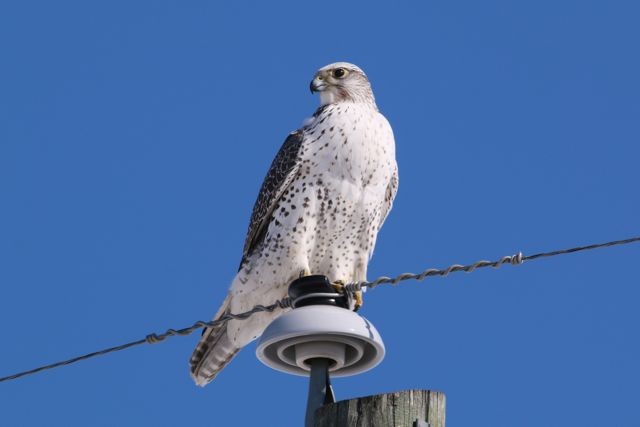Gyrfalcon
A species of True Falcons, Also known as Greenland Falcon, White Gyrfalcon, Gray Gyrfalcon, Jer Falcon Scientific name : Falco rusticolus Genus : True Falcons
Gyrfalcon, A species of True Falcons
Also known as:
Greenland Falcon, White Gyrfalcon, Gray Gyrfalcon, Jer Falcon
Botanical name: Falco rusticolus
Genus: True Falcons
Content
Description People often ask General Info
Description
Even though the gyrfalcon has less of a presence than other species of falcons, it is still easily identifiable at its Artic breeding ground or when the stocky bird is in flight due to its size and the silvery sheen on the underside of its feathers. Like most falcons, it is a predator feeding primarily on small mammals and other bird species.
Size
51-64 cm (20-25 in)
Life Expectancy
12 years (wild), 7.4-16.6 years (wild)
Nest Placement
Cliff
Clutch Size
1 - 5 eggs
Number of Broods
34 - 36 days
Nestling Period
45 - 50 days
Feeding Habits
Gyrfalcon predominantly preys on ptarmigans, notably Willow and Rock species. Their diet also includes various birds like seabirds, waterfowl, and songbirds, occasionally extending to mammals such as hares and lemmings. Gyrfalcon utilizes high perches or aerial views to spot prey, employing tactics like long pursuits or diving strikes, often resulting in prey with broken breastbones. During breeding, females cache food near the nest.
Habitat
Gyrfalcon is commonly found in the Arctic tundra and alpine regions across northern Canada and Alaska. Preferred habitats of gyrfalcon include rocky seacoasts, offshore islands, and barren landscapes with rocky outcrops, often at elevations above 5,000 feet. The sparse vegetation in these areas comprises sedge, cottongrass, lichen, moss, willow, and birch. In the winter, gyrfalcon may migrate to lower latitudes and elevations below 3,000 feet, inhabiting open terrains such as coasts, farmlands, grasslands, shrublands, and river valleys, in search of abundant avian prey.
Nest Behavior
Both male and female gyrfalcon visit potential nesting sites before breeding, with males outnumbering females during mate advertisement. They do not build their own nests but will scrape a depression where the female lays eggs. The pair shares responsibilities in caring for their young.
Nest Characteristics
Gyrfalcon's nest is typically found on cliffs or in conifer tree nests of other species. They may utilize cliff ledges with overhangs that offer protection from the wind, without much modification. Nest sites range from bare soil to stick structures and lack significant lining but include a central depression scraped out by the pair.
Dite type
Avivorous
People often ask
General Info
Feeding Habits
Bird food type
Behavior
Gyrfalcon lead typically solitary or monogamous lives, often forming lifelong pair bonds. Their day is marked by impressive aerial acrobatics, including dives and rolls, performed by the male. The pairs fiercely protect territories spanning about a mile radius from their cliffside nests, maintaining a distance of up to 60 miles from other pairs. Vigilant defense includes loud calls and direct confrontations, where they may even lock talons with aerial rivals. Even during non-breeding periods, gyrfalcon remain territorial. Their pursuit of prey, which includes fast flights that can exceed 130 mph, showcases their agility and predation prowess. In some instances, gyrfalcon will also chase prey by running or hopping over terrain, demonstrating their adaptability and predatory versatility.
Species Status
Not globally threatened.
Scientific Classification
Phylum
Chordates Class
Birds Order
Diurnal Birds of Prey Family
Falcons and caracaras Genus
True Falcons Species
Gyrfalcon 